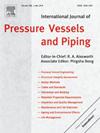Stress corrosion crack propagation behavior in cold worked low-alloy steel SA508 in simulated primary water of PWR
IF 3
2区 工程技术
Q2 ENGINEERING, MECHANICAL
International Journal of Pressure Vessels and Piping
Pub Date : 2025-04-01
DOI:10.1016/j.ijpvp.2025.105523
引用次数: 0
Abstract
This study systematically investigates the stress corrosion crack growth rate (SCCGR) of SA508-Gr3 Cl.2 alloy, a pressure vessel steel for nuclear power plants, under varying cold working (CW) conditions (0 % CW, 10 % CW, 20 % CW, and 30 % CW) in simulated primary water environments. The results demonstrate a strong positive correlation between CW degree and SCCGR, with measured values of 1.81 × 10−8 mm/s (0 % CW), 3.39 × 10−8 mm/s (10 % CW), 4.78 × 10−8 mm/s (20 % CW), and 6.02 × 10−8 mm/s (30 % CW). Compared to the undeformed condition (0 % CW), the SCCGR increased by 87.29 %, 164 %, and 233 % for 10 % CW, 20 % CW, and 30 % CW, respectively. Furthermore, at 30 % CW, the SCCGR exhibited significant oxygen dependence, showing 88.70 % and 157 % increases at dissolved oxygen (DO) concentrations of 100 ppb and 500 ppb, respectively, relative to the low-oxygen condition (DO < 5 ppb). These findings provide critical insights into the synergistic effects of cold working and environmental factors on nuclear-grade pressure vessel steels' stress corrosion cracking behavior.

冷加工低合金钢SA508在压水堆模拟一次水中应力腐蚀裂纹扩展行为
本研究系统研究了核电站压力容器用钢SA508-Gr3 Cl.2合金在模拟原生水环境中不同冷加工条件(0%、10%、20%和30%)下的应力腐蚀裂纹扩展速率(SCCGR)。结果表明,连续度与SCCGR呈正相关,测量值分别为1.81 × 10−8 mm/s(0%连续波)、3.39 × 10−8 mm/s(10%连续波)、4.78 × 10−8 mm/s(20%连续波)和6.02 × 10−8 mm/s(30%连续波)。与未变形条件(0%连续水)相比,10%连续水、20%连续水和30%连续水的SCCGR分别提高了87.29%、164%和233%。此外,在30% CW条件下,SCCGR表现出明显的氧依赖性,在溶解氧(DO)浓度为100 ppb和500 ppb时,SCCGR分别比低氧条件下(DO <;5磅)。这些发现为冷加工和环境因素对核级压力容器钢应力腐蚀开裂行为的协同效应提供了重要的见解。
本文章由计算机程序翻译,如有差异,请以英文原文为准。
求助全文
约1分钟内获得全文
求助全文
来源期刊
CiteScore
5.30
自引率
13.30%
发文量
208
审稿时长
17 months
期刊介绍:
Pressure vessel engineering technology is of importance in many branches of industry. This journal publishes the latest research results and related information on all its associated aspects, with particular emphasis on the structural integrity assessment, maintenance and life extension of pressurised process engineering plants.
The anticipated coverage of the International Journal of Pressure Vessels and Piping ranges from simple mass-produced pressure vessels to large custom-built vessels and tanks. Pressure vessels technology is a developing field, and contributions on the following topics will therefore be welcome:
• Pressure vessel engineering
• Structural integrity assessment
• Design methods
• Codes and standards
• Fabrication and welding
• Materials properties requirements
• Inspection and quality management
• Maintenance and life extension
• Ageing and environmental effects
• Life management
Of particular importance are papers covering aspects of significant practical application which could lead to major improvements in economy, reliability and useful life. While most accepted papers represent the results of original applied research, critical reviews of topical interest by world-leading experts will also appear from time to time.
International Journal of Pressure Vessels and Piping is indispensable reading for engineering professionals involved in the energy, petrochemicals, process plant, transport, aerospace and related industries; for manufacturers of pressure vessels and ancillary equipment; and for academics pursuing research in these areas.

 求助内容:
求助内容: 应助结果提醒方式:
应助结果提醒方式:


